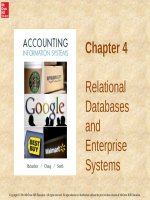Lecture management information systems chapter 12 enhancing decision making
Bạn đang xem bản rút gọn của tài liệu. Xem và tải ngay bản đầy đủ của tài liệu tại đây (939.22 KB, 10 trang )
Chapter 12
Enhancing Decision
Making
VIDEO CASES
Video Case 1: FreshDirect Uses Business Intelligence to Manage Its Online Grocery
Video Case 2: Business Intelligence Helps the Cincinnati Zoo
Instructional Video 1: FreshDirect’s Secret Sauce: Customer Data From the
Website
Instructional Video 2: A Demonstration of Oracle’s Mobile Business Intelligence
App
6.1
Copyright © 2014 Pearson Education, Inc. publishing as Prentice Hall
Management Information Systems
Chapter 12: Enhancing Decision Making
Learning Objectives
• What are the different types of decisions and how does the
decision-making process work? How do information systems
support the activities of managers and management
decision making?
• How do business intelligence and business analytics support
decision making?
• How do different decision-making constituencies in an
organization use business intelligence? What is the role of
information systems in helping people working in a group
make decisions more efficiently?
12.2
Copyright © 2016 Pearson Education, Inc.
Management Information Systems
Chapter 12: Enhancing Decision Making
Germany Wins the World Cup with Big Data at Its Side
• Problem: Extreme competition;
opportunities from new technology
• Solutions: Use improved statistical analysis
to identify player weaknesses and strengths,
use new metrics to improve player and team
performance
• Demonstrates the use of business
intelligence to develop better performance
metrics
12.3
Copyright © 2016 Pearson Education, Inc.
Management Information Systems
Chapter 12: Enhancing Decision Making
Decision Making and Information Systems
• Business value of improved decision making
– Improving hundreds of thousands of “small” decisions
adds up to large annual value for the business
• Types of decisions:
– Unstructured: Decision maker must provide
judgment, evaluation, and insight to solve problem
– Structured: Repetitive and routine; involve definite
procedure for handling so they do not have to be
treated each time as new
– Semistructured: Only part of problem has clear-cut
answer provided by accepted procedure
12.4
Copyright © 2016 Pearson Education, Inc.
Management Information Systems
Chapter 12: Enhancing Decision Making
Decision Making and Information Systems
• Senior managers:
– Make many unstructured decisions
– For example: Should we enter a new market?
• Middle managers:
– Make more structured decisions but these may include unstructured
components
– For example: Why is order fulfillment report showing decline in
Minneapolis?
• Operational managers, rank and file
employees
– Make more structured decisions
– For example: Does customer meet criteria for credit?
12.5
Copyright © 2016 Pearson Education, Inc.
Management Information Systems
Chapter 12: Enhancing Decision Making
INFORMATION REQUIREMENTS OF KEY DECISION-MAKING GROUPS IN A FIRM
FIGURE 12-1
12.6
Senior managers, middle managers, operational managers, and employees have different types of decisions and
information requirements.
Copyright © 2016 Pearson Education, Inc.
Management Information Systems
Chapter 12: Enhancing Decision Making
Decision Making and Information Systems
• The four stages of the decision-making process
1. Intelligence
• Discovering, identifying, and understanding the problems
occurring in the organization
2. Design
• Identifying and exploring solutions to the problem
3. Choice
• Choosing among solution alternatives
4. Implementation
• Making chosen alternative work and continuing to monitor
how well solution is working
12.7
Copyright © 2016 Pearson Education, Inc.
Management Information Systems
Chapter 12: Enhancing Decision Making
STAGES IN DECISION MAKING
The decision-making process is
broken down into four stages.
FIGURE 12-2
12.8
Copyright © 2016 Pearson Education, Inc.
Management Information Systems
Chapter 12: Enhancing Decision Making
Decision Making and Information Systems
• Information systems can only assist in some
of the roles played by managers
• Classical model of management: five
functions
– Planning, organizing, coordinating, deciding, and
controlling
• More contemporary behavioral models
– Actual behavior of managers appears to be less
systematic, more informal, less reflective, more reactive,
and less well organized than in classical model
12.9
Copyright © 2016 Pearson Education, Inc.
Management Information Systems
Chapter 12: Enhancing Decision Making
Decision Making and Information Systems
• Mintzberg’s 10 managerial roles
– Interpersonal roles
1. Figurehead
2. Leader
3. Liaison
– Informational roles
4. Nerve center
5. Disseminator
6. Spokesperson
– Decisional roles
7.
8.
9.
10.
12.10
Entrepreneur
Disturbance handler
Resource allocator
Negotiator
Copyright © 2016 Pearson Education, Inc.









